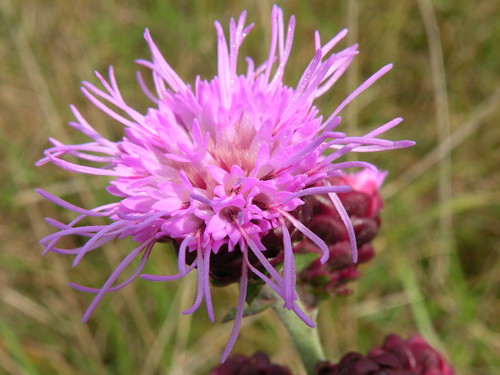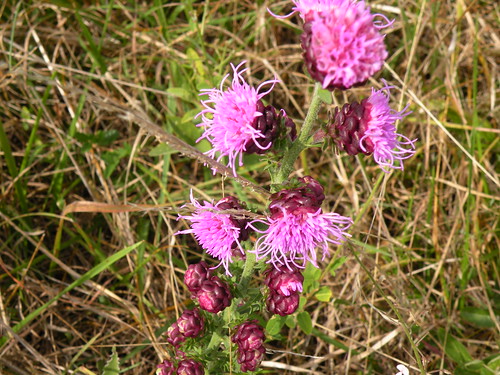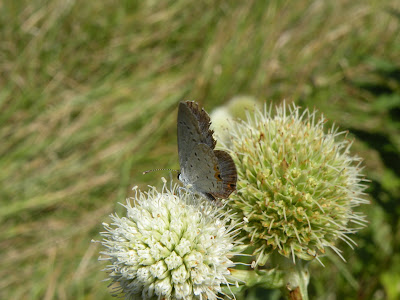
Wednesday, August 26, 2009
More blazing star
Please click on image to go to Flickr photos, then use took above the photos to ENLARGE one to three times to view detail.


Sunday, August 23, 2009
Saturday, August 22, 2009
Monarch butterfly, caterpillars and grasshopper on milkweed on August 21 and 22, 2009
Please click on top image to ENLARGE view of monarch butterfly nectaring on swamp milkweed on August 21, 2009.

Please click on images to ENLARGE view of swamp milkweed with several tiny monarch butterfly caterpillars and a green grasshopper feeding on something. Is he in charge of birth control for butterflies, reducing the population so that some few caterpillars will be able to get to adulthood as monarchs?




Please click on images to ENLARGE view of swamp milkweed with several tiny monarch butterfly caterpillars and a green grasshopper feeding on something. Is he in charge of birth control for butterflies, reducing the population so that some few caterpillars will be able to get to adulthood as monarchs?



Thursday, August 20, 2009
Karst map of NW Arkansas significant tool for identifying green infrastructure deserving of protection
Please click on images to ENLARGE to read and see detail.


http://watershedwarrior.blogspot.com
The Town Branch Neighborhood is the smallest rectangle on that map. Enlarge the chart to read it.
Our neighborhood is a small hotspot for groundwater recharge and you can see how the wetland with springs and depressed land coincides with the karst coloring when you click and blow up the map.
Although the Nature Conservancy guys who created it admit that more ontheground investigation (and underground) to confirm a stricter scientific map is needed, it matches what I have believed about our neighborhood for some time. You can see the national cemetery circle with the karst just to the north along the old alley between Gov ave and Hill ave and pinnacle and wpwp are bright as is my own yard!
Please note one particular error. Cato Springs Branch, a northeast-flowing tributary of the Town Branch, is mistakenly called the Town Branch on the map. The oldest available government maps mark the portion of the Town Branch that flows from the UA and through our neighborhood as the Town Branch.
This is a significant tool for working on green-infrastructure plans and the FNHA already has it but in PDFs, which I can't post on the blogs.
Aubrey James Shepherd


http://watershedwarrior.blogspot.com
The Town Branch Neighborhood is the smallest rectangle on that map. Enlarge the chart to read it.
Our neighborhood is a small hotspot for groundwater recharge and you can see how the wetland with springs and depressed land coincides with the karst coloring when you click and blow up the map.
Although the Nature Conservancy guys who created it admit that more ontheground investigation (and underground) to confirm a stricter scientific map is needed, it matches what I have believed about our neighborhood for some time. You can see the national cemetery circle with the karst just to the north along the old alley between Gov ave and Hill ave and pinnacle and wpwp are bright as is my own yard!
Please note one particular error. Cato Springs Branch, a northeast-flowing tributary of the Town Branch, is mistakenly called the Town Branch on the map. The oldest available government maps mark the portion of the Town Branch that flows from the UA and through our neighborhood as the Town Branch.
This is a significant tool for working on green-infrastructure plans and the FNHA already has it but in PDFs, which I can't post on the blogs.
Aubrey James Shepherd
Monday, August 17, 2009
Butterfly nectars on inflorescence of Verbesina virginica on August 17, 2009, at World Peace Wetland Prairie
Saturday, August 15, 2009
Peter Carrington identified this tiny flower as Sida spinosa, a member of the family Malvaceae
Please click on image to ENLARGE view of tiny Sida spinosa that I don't remember seeing before but which came up voluntarily from fill dirt spread as topsoil on the new parkland adjacent to World Peace Wetland Prairie. I would like to know as soon as possible whether this is native, how invasive it may be, etc. It may already exist on WPWP but I don't think so. If it is allowed to stay, then it will join the WPWP mix, and WPWP volunteers are trying to remove invasive species.

The fill dirt on top of the park is to be dug out. If this and many other volunteer plants on the new park are invasive, the dirt must not be deposited anywhere along the new trail across Pinnacle Prairie or near WPWP.

The fill dirt on top of the park is to be dug out. If this and many other volunteer plants on the new park are invasive, the dirt must not be deposited anywhere along the new trail across Pinnacle Prairie or near WPWP.
Insects and flowers: Ya can't one, ya can't have none without the other!
Saturday, August 8, 2009
Friday, August 7, 2009
Spotted, metallic-shiny grasshopper visits swamp milkweed on August 7, 2009
Pinnacle Foods' wet prairie native wildflowers on August 7, 2009, adjacent new to city trail between 12th Street and Hill Place student apartments
Please click on images to ENLARGE view of wild native flowers on Pinnacle wet prairie immediately west of World Peace Wetland Prairie on August 7, 2009.



P
Third photo shows Illinois bundle flower on August 7, 2009. Desmanthus illinoensis is its scientific name. For more information, please see http://www.landinstitute.org/vnews/display.v/ART/2003/01/15/3e774f4876885

Bottom photo displays hairy wild petunia with a pollinator on it on August 7, 2009. Ruellia humilis is its scientific name and it is a member of the Acanthus family (Acanthaceae) For more information, please see http://www.illinoiswildflowers.info/prairie/plantx/hw_petuniax.htm



P
Third photo shows Illinois bundle flower on August 7, 2009. Desmanthus illinoensis is its scientific name. For more information, please see http://www.landinstitute.org/vnews/display.v/ART/2003/01/15/3e774f4876885

Bottom photo displays hairy wild petunia with a pollinator on it on August 7, 2009. Ruellia humilis is its scientific name and it is a member of the Acanthus family (Acanthaceae) For more information, please see http://www.illinoiswildflowers.info/prairie/plantx/hw_petuniax.htm
Thursday, August 6, 2009
Pollinators pile on milkweed on World Peace Wetland Prairie
Tuesday, August 4, 2009
Gray hairstreak butterfly on rattlesnake master on August 4, 2009.
Sunday, August 2, 2009
Tiny white beauties lost in the tall growth on WPWP on August 2, 2009
Saturday, August 1, 2009
American basketflower (Centaurea americana) is NOT a thistle
Subscribe to:
Posts (Atom)

























